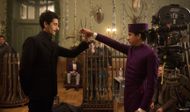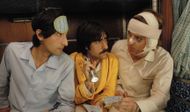Wes Anderson makes movies that look like storybooks turned real. His sets look as if they were designed with a ruler and a paintbrush. His characters speak in short lines that sound strange, but somehow feel honest. Each film builds a world that looks nothing like ours, but still feels familiar. The people inside a Wes Anderson movie carry pain and hope the same way anyone would. The camera never shakes. The colors never clash. Nothing is left to accident.
You don’t need to know film theory to enjoy what he does. His stories follow kids who run away from home or adults who never really grew up. His heroes are foxes, broken geniuses, or quiet dreamers. None of them fit in. All of them try to.
Over time, Wes Anderson has created a style that stands completely on its own. These seven films are ranked highest on IMDb, and they show why his work sticks with people. The ratings reflect what fans already know.
These are not just good movies. These are stories that stay in your head because no one else tells them this way. If you want to see what makes Wes Anderson different, this list is a solid place to begin.
7 Wes Anderson movies ranked by IMDb that prove he’s the Picasso of weird but genius cinema
1. The Grand Budapest Hotel (8.1)

The story follows Gustave H, who works as a concierge at a famous hotel in the Republic of Zubrowka. He trains a young lobby boy named Zero, who becomes his trusted friend. Their lives change when Gustave is accused of murder after inheriting a priceless painting from a wealthy guest.
The film unfolds through several time periods and includes action, chases, secret codes, and a prison escape. Its colors are bold and the locations feel like pages from an illustrated book. The characters are both funny and sad in ways that feel real even in a surreal setting.
This film is widely considered Wes Anderson’s best work. It won four Oscars and often ranks highest in fan and critic lists. The rating reflects how it blends style and story without losing control. Every detail feels carefully placed and every line carries purpose without needing to explain itself.
2. Fantastic Mr. Fox (7.9)

Mr. Fox used to steal chickens but gave it up to raise a family and live a quiet life. He gets restless and plans one last round of thefts against three mean farmers. His actions put every animal in danger and forced him to figure out how to save his community.
This Wes Anderson movie uses stop-motion animation with real textures that make fur, food, and dirt feel alive. The voice work by George Clooney adds charm while the script keeps the tone sharp and fast. Every scene moves the story forward without wasting time.
The film stands out for turning a short children’s book into a complex story about pride and teamwork. The 7.9 rating fits how people responded to its humor, detail, and heart. It showed that Wes Anderson’s style works outside of live action and proved animation can carry the same emotional depth when done with this level of care.
3. Moonrise Kingdom (7.8)

Sam is a lonely orphan who runs away from scout camp with Suzy, who feels ignored by her family. They hide in the wild while a group of adults and kids try to find them. Their escape sets off a storm that changes everyone involved.
The film uses flat camera angles, soft lighting, and muted colors to match the quiet emotion in every scene. The child actors are calm and serious which gives their love story weight. The adults, like Bruce Willis and Edward Norton, play their roles with restraint, not exaggeration.
This movie earned an Oscar nomination for its script and became a favorite for its honesty. The 7.8 rating reflects how viewers connected with its tone and characters. It treats young love without mocking it and builds a world where every detail feels like it belongs. It remains one of Wes Anderson’s most carefully controlled and emotionally rich stories.
4. Isle of Dogs (7.8)

A flu outbreak in Japan leads to all dogs being exiled to a trash-covered island. A boy named Atari flies there to find his lost dog, Spots. He meets a pack of dogs who help him survive the island and fight against corrupt leaders back home.
The stop-motion design makes everything feel worn and real. The dogs have rough fur and broken teeth but speak with warmth and thought. The use of untranslated Japanese adds another layer that makes viewers listen more closely to behavior and tone.
The story mixes politics, loyalty, and family without turning preachy. Its 7.8 rating reflects how deeply crafted the world feels. Fans praised its risk-taking and visual strength. The film takes a dark premise and turns it into a quiet story about trust and friendship. It proved that Wes Anderson could push into new places while still sounding like himself without copying his earlier work.
5. The Royal Tenenbaums (7.6)

The Tenenbaum children were once brilliant but now live with regret and failure. Their father, Royal, returns after years of absence by lying about being sick. His goal is to win back the love of his strange and broken family.
Each character has a personal struggle, and the house they live in looks frozen in time. The camera stays still and the shots are arranged like a stage. Costumes and music mirror each character’s emotional state. The tone is dry but there is emotion underneath it.
This film shaped Wes Anderson’s style going forward. It was nominated for an Oscar for Best Original Screenplay. The 7.6 rating reflects how it built a world that feels both distant and familiar. It showed that movies can be sad and funny at the same time without feeling fake. The film’s look and dialogue have been copied by many but rarely matched.
6. Rushmore (7.6)

Max is a student who joins every club at Rushmore Academy but fails most of his classes. He falls in love with a teacher—and so does his older friend, Herman. Their friendship breaks and leads to a strange battle over her attention.
The story shows Max as overly confident but deeply insecure. The film uses music from the 1960s with cuts that feel like flipping through a scrapbook. Bill Murray plays Herman as worn down but still hopeful. Each moment feels both absurd and grounded in real feelings.
This was Wes Anderson’s second film and became his breakthrough. The 7.6 rating reflects how it found fans who saw parts of themselves in Max. The movie looks simple but every choice adds to the story. It proved Anderson could tell personal stories in a way that stands out without making things too sentimental. It marked the start of his long-time work with Murray.
7. The Darjeeling Limited (7.2)

Three brothers meet in India a year after their father’s death. They travel together on a train, trying to reconnect while each of them deals with private grief. Their trip starts with set plans but slowly falls apart as tensions rise.
The setting includes temples, markets, and trains, all shot with bright colors and slow camera movements. The brothers carry matching luggage and personal guilt. Owen Wilson, Jason Schwartzman, and Adrien Brody all play men who do not say what they mean.
The film feels more open and raw than some of Wes Anderson’s other work. The 7.2 rating reflects how some people saw depth in its messiness, while others felt it was too quiet. It is not as tight as his highest-rated film,s but it remains a strong example of how his stories can stretch and explore without losing meaning. The film shows grief in ways that feel slow but real.
Follow for more updates.
Love movies? Try our Box Office Game and Movie Grid Game to test your film knowledge and have some fun!
